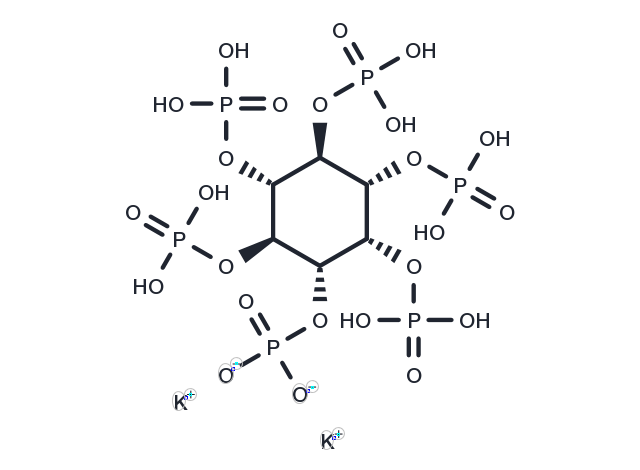Powder: -20°C for 3 years | In solvent: -80°C for 1 year


Phytic acid potassium (Inositol polyphosphate dipotassium salt) exists in all eukaryotic cells. In plants, it is known to function as a [PO4]3 storage depot and precursor for other inositol phosphates and pyrophosphates. It can be used clinically as a complexing agent for removal of traces of heavy metal ions. It acts also as a hypocalcemic agent. Phytic acid is a strong chelator of important minerals such as calcium, magnesium, iron, and zinc. In yeast, phytic acid acts with the nuclear pore protein Gle1 to regulate the nuclear export of mRNA by coactivating the RNA-dependent ATPase activity of DExD-box protein 5 (Dbp5).

| Pack Size | Availability | Price/USD | Quantity |
|---|---|---|---|
| 100 mg | In stock | $ 41.00 | |
| 1 mL * 10 mM (in H2O) | In stock | $ 45.00 |



| Description | Phytic acid potassium (Inositol polyphosphate dipotassium salt) exists in all eukaryotic cells. In plants, it is known to function as a [PO4]3 storage depot and precursor for other inositol phosphates and pyrophosphates. It can be used clinically as a complexing agent for removal of traces of heavy metal ions. It acts also as a hypocalcemic agent. Phytic acid is a strong chelator of important minerals such as calcium, magnesium, iron, and zinc. In yeast, phytic acid acts with the nuclear pore protein Gle1 to regulate the nuclear export of mRNA by coactivating the RNA-dependent ATPase activity of DExD-box protein 5 (Dbp5). |
| Synonyms | Inositol hexakisphosphate dipotassium salt, Phytic acid dipotassium salt, Fytic Acid dipotassium salt, Inositol polyphosphate dipotassium salt |
| Molecular Weight | 736.22 |
| Formula | C6H16K2O24P6 |
| CAS No. | 129832-03-7 |
Powder: -20°C for 3 years | In solvent: -80°C for 1 year
DMSO: Insoluble
H2O: 10 mM
You can also refer to dose conversion for different animals. More
bottom
Please see Inhibitor Handling Instructions for more frequently ask questions. Topics include: how to prepare stock solutions, how to store products, and cautions on cell-based assays & animal experiments, etc.
Phytic acid potassium 129832-03-7 Metabolism Others Endogenous Metabolite Phytic acid dipotassium inhibit Inositol polyphosphate dipotassium Fytic Acid dipotassium Inositol hexakisphosphate dipotassium Inositol hexakisphosphate dipotassium salt Fytic Acid Inositol polyphosphate Phytic acid dipotassium salt Fytic Acid dipotassium salt Inositol polyphosphate dipotassium salt Inhibitor Phytic acid Inositol hexakisphosphate inhibitor
